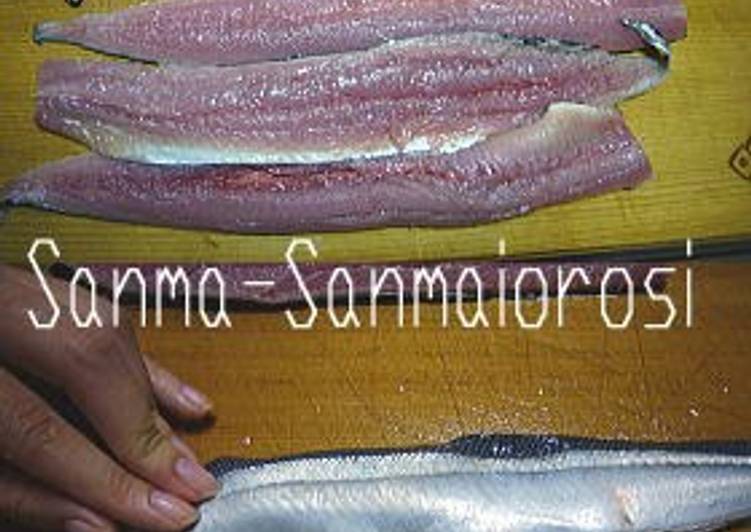How to Filet a Pacific Saury (Sanma). I DO NOT OWN THIS CONTENT. Sanma or Pacific Saury is one of the most well-known seasonal fish representing autumn in Japanese cuisine. It's usually salted and grilled whole even with intestines intact, and served with grated daikon and soy sauce to intensify the flavor of the fish.
 Pacific saury are harvested as food fish in the western Pacific Ocean, with Japan as the major market, and as bait fish elsewhere in the Pacific.
I have not had the chance to try saury, or sanma, as sashimi, although a friend who lived in Japan reports raw sanma as tasting just fine.
The kanji characters for sanma, the Japanese name for the pacific saury, are 秋刀魚 - "fall sword fish".
You can cook How to Filet a Pacific Saury (Sanma) using 1 ingredients and 23 steps. Here is how you cook that.
Pacific saury are harvested as food fish in the western Pacific Ocean, with Japan as the major market, and as bait fish elsewhere in the Pacific.
I have not had the chance to try saury, or sanma, as sashimi, although a friend who lived in Japan reports raw sanma as tasting just fine.
The kanji characters for sanma, the Japanese name for the pacific saury, are 秋刀魚 - "fall sword fish".
You can cook How to Filet a Pacific Saury (Sanma) using 1 ingredients and 23 steps. Here is how you cook that.
Ingredients of How to Filet a Pacific Saury (Sanma)
- It's 1 of Fresh Pacific saury (sanma).
For a long time, sanma was regarded as an inexpensive, everyday fish, eaten in the lean days before payday. The very last movie directed by the great Yasujiro Ozu, best known in the west for his. The arrival of 'Pacific Saury', a thin sword-like fish called 'Sanma' signifies the arrival of autumn and is probably one of the most popular fish in Japan during this short season. Great recipe for Pacific Saury Ginger Simmered in a Pressure Cooker.
How to Filet a Pacific Saury (Sanma) instructions
- Wet your cutting board. Place the knife on the far side of the board, and have a kitchen towel ready too. This is the basic mis en place? for professionals. I used a 15 cm knife..
- You are supposed to hold your knife like this when cutting up a fish, put your index finger on the back of the blade..
- Scrape the scales off the fish by scraping the knife lightly over it..
- Insert the knife into the gill and cut off the head..
- The head is cut off..
- Cut into the belly of the fish from the tail end towards the head..
- The belly is cut now. Wash and scrape the guts out under running water..
- This is how it looks after the guts have been washed out. Pat dry with kitchen towel..
- Score the belly of the fish, then cut into it towards the backbone. When the knife hits the backbone, stop..
- The white line shown in the photo represents the back bone. Cut up to the red part, and stop your blade at the bone..
- Score the back side of the fish. Using that as a guideline, cut into the fish towards the bone..
- The white part is the back bone. Cut up to the red part, and stop your blade at the bone..
- Insert the knife from the tail end over the bone. Hold the tail with your left hand as you do this..
- Holding the tail with your left hand, run the knife over the bone as you cut it. You go from left to right as shown in the photo..
- It will look like this..
- Score the rest of the fish on the belly side in the same way, then cut into the fish towards the bone, holding your knife at a 45 degree angle..
- Score and cut the back side towards the bone in the same way..
- Insert the knife into the tail end as in Step 10, and cut and slide it over the bone. Work from the tail end towards the head end..
- The fish is now divided into three parts..
- There are some small bones in this regions, to slice through them with the knife..
- Remove the small bones with fish bone tweezers and you're done! I bought mine from a 100 yen shop..
- For pan frying you can just leave the skin on..
- If you want to remove the skin, start from the head end and peel it off slowly with your hands. It should peel right off..
I wanted to eat a pacific How to fillet Pacific saury. Suchen Sie nach Homemade Sandwich Pacific Saury Japanese Sanma-Stockbildern in HD und Millionen weiteren lizenzfreien Stockfotos, Illustrationen und Vektorgrafiken in der Shutterstock-Kollektion. Jeden Tag werden Tausende neue, hochwertige Bilder hinzugefügt. Sanma-no-shioyaki is served with grated daikon radish and often a wedge or two of sudachi, a distinctive Japanese citrus that really brings out and accentuates many flavors in. Broiled Pacific Saury is a dish made in Cooking Mama: World Kitchen.